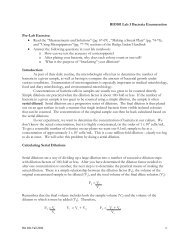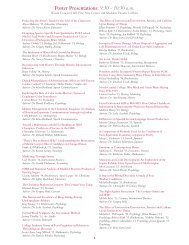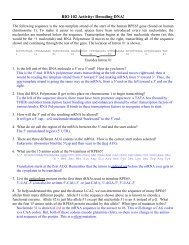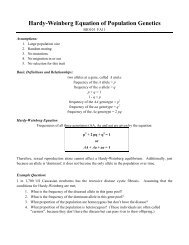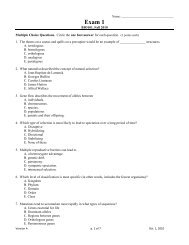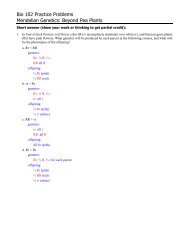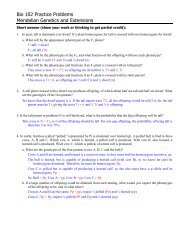Bio 102 Practice Problems Mendel: Principles of Inheritance
Bio 102 Practice Problems Mendel: Principles of Inheritance
Bio 102 Practice Problems Mendel: Principles of Inheritance
Create successful ePaper yourself
Turn your PDF publications into a flip-book with our unique Google optimized e-Paper software.
<strong>Bio</strong> <strong>102</strong> <strong>Practice</strong> <strong>Problems</strong><br />
<strong>Mendel</strong>: <strong>Principles</strong> <strong>of</strong> <strong>Inheritance</strong><br />
Multiple choice: Unless otherwise directed, circle the one best answer (2 points each)<br />
1. The first person to apply experimental techniques and mathematical analysis to the study <strong>of</strong> inheritance was:<br />
A. Darwin<br />
B. Aristotle<br />
C. Tschermak<br />
D. <strong>Mendel</strong><br />
E. Hippocrates<br />
2. <strong>Mendel</strong> succeeded where others had failed in part because <strong>of</strong>:<br />
A. his knowledge <strong>of</strong> chromosomes<br />
B. his understanding <strong>of</strong> DNA structure<br />
C. his use <strong>of</strong> mathematics and statistics<br />
D. his acceptance <strong>of</strong> Darwin’s evolutionary theory<br />
E. his use <strong>of</strong> fruit flies as experimental organisms<br />
Short answer (show your work or thinking to get partial credit):<br />
1. If the allele for tall is represented by T and the allele for dwarf by t, give the gametes produced by the parents<br />
and the phenotypes <strong>of</strong> the <strong>of</strong>fspring for each <strong>of</strong> the following crosses:<br />
a. Tt × tt<br />
Gametes:<br />
Tt parent: ½ T and ½ t<br />
tt parent: all t<br />
Offspring:<br />
½ Tt, tall<br />
½ tt, dwarf<br />
b. TT × Tt<br />
Gametes:<br />
TT parent: all T<br />
Tt: ½ T and ½ t<br />
Offspring:<br />
all tall (½ Tt, and ½ TT)<br />
c. Tt × Tt<br />
Gametes: ½ T and ½ t from each parent<br />
Offspring:<br />
¾ tall (¼ TT and ½ Tt)<br />
¼ dwarf (tt)
2. A pure-breeding, tall pea plant is crossed with a pure-breeding, short pea plant. All <strong>of</strong> the <strong>of</strong>fspring <strong>of</strong> this<br />
cross are tall.<br />
a. Which allele is dominant, and how do you know?<br />
Because the parents are pure-breeding, the <strong>of</strong>fspring must be heterozygous. The dominant allele is defined<br />
as the one that produces the phenotype <strong>of</strong> the heterozygous individuals, so tall is dominant.<br />
b. What are the genotypes <strong>of</strong> these <strong>of</strong>fspring?<br />
If T=tall and t=short, all are Tt.<br />
c. Suppose two <strong>of</strong> these <strong>of</strong>fspring are crossed and produce 1000 <strong>of</strong>fspring. How many tall and how many<br />
short plants will you expect?<br />
We expect ¾ <strong>of</strong> the <strong>of</strong>fspring to be either TT or Tt, so 750 tall; ¼ should be short, or 250.<br />
d. How many <strong>of</strong> each genotype would you expect among the 1000 <strong>of</strong>fspring?<br />
The 250 short plants are all tt. The 750 tall are actually TT and Tt, and ¼ <strong>of</strong> the total is expected to be TT<br />
with ½ Tt, so 250 TT and 500 Tt.<br />
3. While tromping through the woods, you come across a very unusual animal: an odorless skunk. Of course,<br />
you immediately want to study the inheritance <strong>of</strong> this trait! Since you don’t have any pure-breeding skunks<br />
around, you cross your odorless skunk with an ordinary, stinky skunk chosen at random. Half <strong>of</strong> the 18<br />
<strong>of</strong>fspring are odorless, and half are smelly.<br />
a. There are two different ways you could’ve gotten this result. Diagram both possible crosses below,<br />
showing genotypes and phenotypes <strong>of</strong> parents and <strong>of</strong>fspring. Be sure to define your symbols!<br />
Possibility #1<br />
If stinky is dominant, S = stinky, s = odorless<br />
Possibility #2<br />
If odorless is dominant, O = odorless, o = stinky<br />
Stinky parent must be heterozygous (to get ½<br />
odorless <strong>of</strong>fspring), so the cross is ss × Ss<br />
Offspring are:<br />
½ Ss, stinky<br />
½ ss, odorless<br />
Stinky parent must be homozygous, so odorless<br />
skunk must be heterozygous (to get ½ odorless<br />
<strong>of</strong>fspring), so the cross is Oo × oo<br />
Offspring are: ½ Oo, odorless<br />
½ oo, stinky<br />
b. Now, what one further cross could you do in order to decide which possibility is the correct one?<br />
An easy way would be to cross two odorless skunks. If possibility #1 is correct, then this cross will be<br />
ss × ss, and all the <strong>of</strong>fspring will be odorless. If possibility #2 is correct, then the cross is Oo × Oo,<br />
and the <strong>of</strong>fspring will be about ¾ odorless, ¼ stinky.<br />
4. A male’s genotype is AaBBCCddEeFF. What fraction <strong>of</strong> the sperm cells produced by this individual will<br />
carry the dominant A allele, the dominant C allele and the recessive e allele?<br />
All the gametes will get the dominant C allele. Half will get the dominant A allele (the other half get a).<br />
And, half will get the recessive e allele (the other half get E). If these genes assort independently, ¼<br />
(½ × ½) will get the combination <strong>of</strong> A, C and e.
True or False? Read carefully: a question is false unless it is completely true!<br />
T□ F■ 1. The importance <strong>of</strong> <strong>Mendel</strong>'s work was recognized by many <strong>of</strong> his contemporaries, including<br />
Darwin.<br />
T□ F■ 2. Genes control simple traits like hair color and blood type, but more complex characteristics such<br />
as development and behavior <strong>of</strong> higher organisms are usually not genetic.<br />
T■ F□ 3. The effect <strong>of</strong> a recessive allele is seen phenotypically only in a homozygous individual.<br />
T□ F■ 4. We can tell which allele is dominant because it produces a larger size, darker color or some other<br />
kind <strong>of</strong> stronger characteristic.<br />
T■ F□ 5. We can predict the overall outcome <strong>of</strong> a genetic cross, given a large number <strong>of</strong> <strong>of</strong>fspring, but not<br />
the specific outcome <strong>of</strong> one fertilization event.<br />
T□ F■ 6. Any gene can come in one <strong>of</strong> two forms, called alleles.<br />
T□ F■ 7. <strong>Mendel</strong>’s work helped Darwin better understand the genetic basis <strong>of</strong> natural selection.<br />
T□ F■ 8. Darwin was the first to publish a scientific theory that effectively explained how traits are<br />
inherited<br />
T□ F■ 9. Darwin was the first to base a theory <strong>of</strong> genetics on experiments and evidence.<br />
T■ F□ 10. <strong>Mendel</strong>’s Law <strong>of</strong> Segregation says each gamete gets one allele <strong>of</strong> each gene.<br />
T□ F■ 11. Pure-breeding individuals could be either homozygous dominant or heterozygous.<br />
T■ F□ 12. There could be hundreds <strong>of</strong> alleles <strong>of</strong> a particular gene in the population as a whole, but one<br />
individual can only have one or two different alleles for that gene.<br />
T■ F□ 13. Each cell in your body has the same set <strong>of</strong> genes, and each cell has two alleles for each gene.<br />
T■ F□ 14. Every person has the same set <strong>of</strong> genes, though they may not have the same alleles.<br />
T□ F■ 15. If the genotypes <strong>of</strong> the two parents are known (for a particular gene), <strong>Mendel</strong>ian genetics can be<br />
used to accurately predict the genotype <strong>of</strong> their child.<br />
T■ F□ 16. A haploid gamete (sperm or egg cell) has the same genes as a diploid body cell.
Fill in the blank:<br />
1. Most <strong>of</strong> your body cells are diploid, meaning they have two alleles <strong>of</strong> each gene. However, gamete cells are<br />
haploid, meaning they have only one allele <strong>of</strong> each gene.<br />
2. A gene is typically responsible for one inherited character, while a(n) allele is a form <strong>of</strong> a gene that produces<br />
one inheritable trait.<br />
3. An individual’s genetic makeup is referred to as his/her genotype, while the visible or measurable effects <strong>of</strong><br />
that genetic makeup is called the phenotype.<br />
4. In a cross between two true-breeding parents, the allele that produces the phenotype seen in the F 1 generation<br />
is considered to be the dominant allele.<br />
5. If an individual is true-breeding, we can say that he/she is homozygous for the gene we are looking at.



